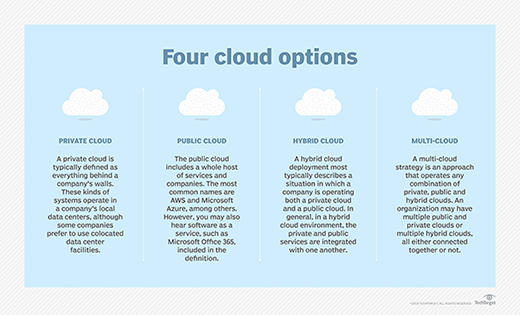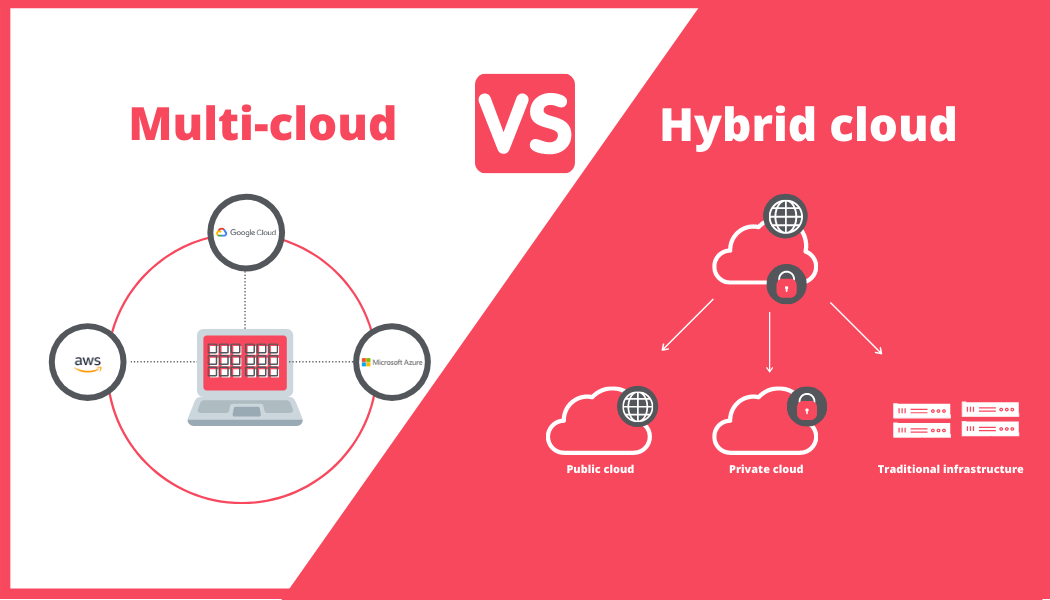Private vs Hybrid Clouds
A cloud computing system enables businesses to store and analyze data using cutting-edge technology over the internet. They are typically classified as public, private, hybrid, or multi-cloud (a combination of the previous three).

Cloud technologies are constantly evolving, so businesses must invest in the latest trends to stay ahead of the competition.
Cloud deployment models govern how data is kept, how customers interact with it, and how cloud-deployed applications function. We will look at the distinctions and applications of each of the three types of cloud deployment.
What is a public cloud?
The public cloud is a computing model that delivers IT services through the internet. The public cloud, the most common model of cloud computing services, provides a wide range of solutions and computing resources to meet the rising needs of enterprises of all sizes and verticals.
The public cloud is typically defined as having high scalability and elasticity, allowing for low-cost subscription-based pricing.
Public cloud services can be free, freemium, or subscription-based, with charges dependent on the computing resources used.
Computing functionality can range from simple services such as email, apps, and storage to enterprise-grade operating systems and infrastructure environments used for software development and testing.
The cloud provider is in charge of creating, managing, and maintaining a pool of computing resources that various tenants from across the network share.
Pros and cons of the public cloud
There are several advantages to a public cloud deployment
- The public cloud is highly scalable, given there is no need to invest in hardware to improve the infrastructure. It can scale up according to demand.
- Subscription and pay-as-you-go pricing models mean you only need to pay for what you use.
- No requirement for hardware updates and maintenance.
- Minimal technical knowledge is required in-house for setting up a public cloud.
- Services are available to everyone who needs them.
Disadvantages of public cloud solutions include the following.
- Specific organizational requirements around security could put up barriers to using public cloud solutions.
- Public clouds may not meet your legal, compliance, or industry requirements.
- The organization does not own the infrastructure, which could restrict services and usage.
- SaaS public systems do not always meet bespoke business requirements.
What is a private cloud?
Any cloud system dedicated to a single enterprise is called a private cloud. You do not share cloud computing resources with any other organization in the private cloud.
The data center resources may be on-site or off-site and managed by a third-party vendor. The computing resources are isolated and distributed through a secure private network and are not shared with other clients.
The private cloud is adaptable to the organization’s specific business and security requirements. Organizations may operate compliance-sensitive IT workloads with greater visibility and control into the infrastructure without sacrificing the security and performance traditionally only available with specialized on-premise data centers.
Pros and cons of the private cloud
Advantages of a private cloud solution include:
- Ensuring the configuration can support all application and legacy system scenarios
- You can control the security of your cloud deployment
- Private cloud meets any compliance, legal, and security requirements for the organization
The typical cons of a private cloud system are:
- Expenditure to configure and maintain the necessary hardware
- In-house skills are required for managing and leveraging a private cloud infrastructure
- There may be limitations on scalability as it requires new hardware to be purchased and installed
What is a hybrid cloud?
Any cloud infrastructure architecture comprising public and private cloud solutions is called a hybrid cloud.
Typically, the resources are orchestrated as an integrated infrastructure environment. Based on corporate business and technical policies, apps and data workloads can share resources between public and private cloud deployments.
Pros and cons of a hybrid cloud
There are various benefits to deploying a hybrid cloud setup.
- You can keep any system that requires outdated hardware or an antiquated operating system operational and accessible.
- A hybrid system gives more flexibility and scalability than on-premises infrastructure.
- Takes advantage of the economies of scale that come with public cloud deployments.
- Organizations can still use their own systems to ensure security and compliance requirements are met.
However, there are still some considerations when opting for a hybrid setup.
- It can be complicated to set up and manage when integrating public and private environments.
- The cost is likely higher than sticking to a single (private or public) method.
Multicloud vs hybrid cloud?
In a multi-cloud environment, a company uses various public cloud services, typically from distinct providers. For example, a company may host its online front-end application on AWS while hosting its Exchange servers on Microsoft Azure.

Because not all cloud providers are created equal, organizations adopt a multi-cloud strategy to deliver best-of-breed IT services, to avoid being locked to one provider, or to take advantage of cloud arbitrage and choose suppliers for particular elements depending on which offers the lowest price at the time.
Incorporating private cloud infrastructure, such as an enterprise’s own data center, alongside one or more public cloud services, usually operating in tandem to meet business goals, distinguishes hybrid cloud computing from multi-cloud computing.
Factors to consider when choosing a cloud strategy
The question is whether you should be looking towards a single public cloud model, a hybrid model, or a multi-cloud model. There is no one-size-fits-all answer, so it’s essential to consider all the factors of each.
The public cloud has revolutionized how many firms undertake IT operations, but many still have a large investment in their own data centers, necessitating hybrid solutions.
Some firms already have on-demand IT resource delivery within their infrastructure and do not require a public cloud. Others build private clouds because their workloads do not fit well in the public cloud due to security or compliance concerns.
Suppose you look at any significant cloud providers (AWS, Azure, Google Cloud) or many third-party software developers. In that case, you will notice that they offer to merge cloud and on-premise resources to make management, backups, and so on easier. Naturally, the experience is constantly enhanced when your preferred cloud provider delivers most of the applications you use on-premise.
For example, VMware Cloud on AWS (or the Azure and Google equivalents) can help with deploying the public cloud’s security and compliance challenges. Products such as Red Hat OpenShift rely on the portability of containers and Kubernetes while providing the PaaS that a public cloud vendor would typically give, allowing it to work anywhere.
Other vendors can assist with managing specific aspects of managing technology requirements across multiple environments.
VMWare helps organizations get full value from an infrastructure that spans both private and public environments. You can extend your existing on-premises infrastructure and operations to any public cloud, running enterprise programs with a consistent operating model.
Veeam provides modern-data protection software for virtual and physical infrastructures within a multi-cloud environment.
Nutanix combines the ease and agility of public clouds with the performance and security of private clouds. Whether on-premises or hybrid, centralized management, one-click operations, and AI-driven automation will assure business continuity.
Budget
-
- On-premise often requires more hardware vs public cloud
Big Data
-
- How mature is the business with data to determine storage needs
Third Parties
-
- Public cloud may not require the same contractual obligations as private providers
Compliance
-
- Do you have specific security and compliance requirements?
Performance
-
- How fast do you need to be able to access data?
Scalability
-
- Public clouds can scale in minutes whereas private often takes time
Organization
-
- The industry you are in might be a determining factor between public and private clouds
Summary
The most critical components in choosing a cloud strategy for most enterprises will be affordability, accessibility, reliability, and scalability. Your sector, security, compliance legislation, budget, and future plans will determine whether a private, public, hybrid, or multi-cloud is the right solution for your needs.
The good news is that numerous options suit almost every use case or budget.
